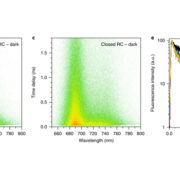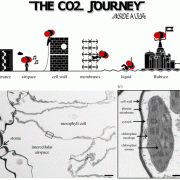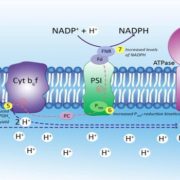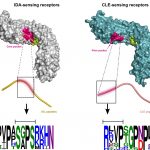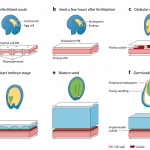Flavodiiron proteins enhance the rate of CO2 assimilation in Arabidopsis under fluctuating light intensity (Plant Physiol)
 Plants must adjust to varying levels of light in order to optimize photosynthetic rates; too little electron transport and plants will incur an energetic penalty, while excessive excitation of photosystem I leads to photodamage. During high light conditions, the increase in DpH acts as a brake on electron transport via acidification of the thylakoid lumen. However in periods of fluctuating light, this can result in a lag period before plants return to optimum photosynthetic rates. In this study, Basso et al. utilized transgenic Arabidopsis lines to examine the potential of an artificial regulatory system to optimize photosynthesis during fluctuating light. Plants overexpressing the H+/K+ antiporter KEA3 can rapidly reduce DpH and thus quickly resume greater rates of photosynthesis, but as a result are also susceptible to photodamage. To negate this effect, the researchers cloned two genes from Physcomitrium patens encoding flavodiirion (Flv) proteins into Arabidopsis. Flv protects against photodamage by utilizing excessive electrons at photosystem I to reduce oxygen to water. The Flv expressing plants not only showed increased CO2 uptake and overall plant growth during fluctuating light compared to wild type plants, but also mitigated the photodamage and decreased growth of KEA3 overexpressing lines during fluctuating light. This work thus highlights a novel avenue to genetically engineer crop species with enhanced photosynthetic abilities, even under challenging light conditions. (Summary by Rory Burke @rorby95) Plant Physiol. 10.1093/plphys/kiac064
Plants must adjust to varying levels of light in order to optimize photosynthetic rates; too little electron transport and plants will incur an energetic penalty, while excessive excitation of photosystem I leads to photodamage. During high light conditions, the increase in DpH acts as a brake on electron transport via acidification of the thylakoid lumen. However in periods of fluctuating light, this can result in a lag period before plants return to optimum photosynthetic rates. In this study, Basso et al. utilized transgenic Arabidopsis lines to examine the potential of an artificial regulatory system to optimize photosynthesis during fluctuating light. Plants overexpressing the H+/K+ antiporter KEA3 can rapidly reduce DpH and thus quickly resume greater rates of photosynthesis, but as a result are also susceptible to photodamage. To negate this effect, the researchers cloned two genes from Physcomitrium patens encoding flavodiirion (Flv) proteins into Arabidopsis. Flv protects against photodamage by utilizing excessive electrons at photosystem I to reduce oxygen to water. The Flv expressing plants not only showed increased CO2 uptake and overall plant growth during fluctuating light compared to wild type plants, but also mitigated the photodamage and decreased growth of KEA3 overexpressing lines during fluctuating light. This work thus highlights a novel avenue to genetically engineer crop species with enhanced photosynthetic abilities, even under challenging light conditions. (Summary by Rory Burke @rorby95) Plant Physiol. 10.1093/plphys/kiac064





